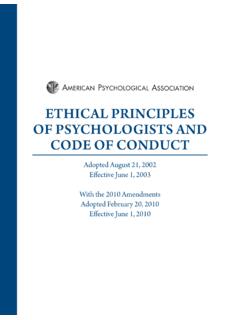Transcription of A Code of Ethics for Psychology - SAGE Publications Inc
1 2 CHAPTER 1A code of Ethics for PsychologyHow Did We Get Here?In a field so complex, where individual and social values are yet but ill defined, the desire to play fairly must be given direction and consistency by some rules of the game. These rules should do much more than help the unethical psychologist keep out of trouble; they should be of palpable aid to the ethical psychologist in making daily decisions. Hobbs (1948, p. 81)BeginningsThe American Psychological Association (APA) has had more than five decades of experience constructing and revising an Ethics code that strives to reflect both the aspirations and practical aspects of ethical decisions made by members of the pro-fession.
2 The creation and each subsequent revision of the APA Ethics code has been driven by the desire for standards that would encourage the highest endeavors of psychologists , ensure public welfare, promote sound relationships with allied pro-fessions, and promote the professional standing of the discipline (Hobbs, 1948).Discussions within APA regarding the need for an Ethics code in Psychology arose in response to an increase in professional activity and public visibility of its members before and after World War II.
3 During this period, the societal value of the still young discipline of Psychology was evidenced as psychologists developed group tests to help the armed services quickly determine the draft eligibility of young men in wartime and provided mental health services to hospitalized soldiers when they returned home. In 1947, the first APA Committee on ethical Standards for psychologists was appointed. The committee, chaired by Edward Tolman, Chapter 1 A code of Ethics for Psychology 3wanted to create a code of Ethics for psychologists that would be more than a document with an imposing title (Hobbs, 1948).
4 The members were committed to producing professional standards that would provide psychologists with a set of values and practical techniques for identifying and resolving moral achieve these goals, the committee decided to draw on the knowledge of the field to create a process of developing a code that would be effective in modifying human behavior (Hobbs, 1948, p. 82). According to Hobbs, This is an old and familiar task to psychologists , their very stock in trade, in fact. The only difference here is that human behavior means specifically the behavior of psychologists (p.)
5 82). Drawing on the knowledge of group processes during that period, the com-mittee conceived the task of developing ethical standards as one of group dynamics (Hobbs, 1948). The process chosen was the critical incident method (Flanagan, 1954), a technique that involved asking the members of the APA to describe a situ-ation they knew of firsthand, in which a psychologist made a decision having ethi-cal implications, and to indicate the ethical issues second committee, chaired by Nicholas Hobbs, reviewed more than 1,000 such incidents submitted by APA members.
6 The committee identified major ethical themes emerging from the incidents that focused on psychologists relationships with and responsibilities to others, including patients, students, research partici-pants, and other professionals. Many of the incidents reflected the political climate of the postwar period, including confrontations between academic freedom and McCarthyism and dilemmas faced by psychologists working in industry asked to design tests for the purpose of maintaining racial segregation in the workforce.
7 As different segments of the code were created, drafts were submitted to the mem-bership for critique and revision. A final draft was adopted by the APA in 1952 and published in Preceding the 2010 Ethics CodeAt the time of the adoption of the first Ethics code , continual review and revision based on the experience and perspectives of members was seen as integral to main-taining the value of the Ethics code for both the profession and the public (Adkins, 1952). As a result, the Ethics code of the APA has undergone eleven revisions since 1953.
8 The 1953 version was more than 170 pages long and included case examples illustrating each ethical standard. The standards themselves were written broadly, using aspirational rather than narrow legalistic language. Subsequent revisions eliminated the cases from the text itself and moved toward more specific the beginning of its more than 50-year history, each revision of the APA s ethical principles of psychologists and code of Conduct has been guided by the following objectives (Hobbs, 1948).
9 To express the best ethical practices in the field as judged by a large represen-tative sample of members of the APA To reflect an explicit value system as well as clearly articulated decisional and behavioral rules4 PART I INTRODUCTION AND BACKGROUND To be applicable to the full range of activities and role relationships encoun-tered in the work of psychologists To have the broadest possible participation among psychologists in its devel-opment and revisions To influence the ethical conduct of psychologists by meriting widespread identification and acceptance among members of the disciplineAspirational principles and Enforceable StandardsAt its heart, an Ethics code should reflect the moral principles underlying the values of the profession.
10 For most professions, ethical behaviors are generally those that fulfill the fundamental moral obligations to do good, to do no harm, to respect others, and to treat all individuals honestly and fairly. For some, statements of gen-eral principles are sufficient to guide the ethical behavior of persons devoted to the ideals of their profession. For others, however, statements describing specific types of behaviors that meet these ideals are necessary to maximize the code s utility and to provide a means of evaluating its efficacy (Schur, 1982).

















